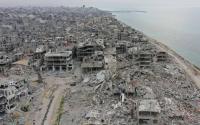Common Dreams / Published on Friday, September 23, 2005 by The Nation (From the October 10, 2005 Issue)
Outside the 2,000-bed temporary shelter in Baton Rouge's River Center, a Church of Scientology band is performing a version of Bill Withers's classic "Use Me"--a refreshingly honest choice. "If it feels this good getting used," the Scientology singer belts out, "just keep on using me until you use me up."
Ten-year-old Nyler, lying face down on a massage table, has pretty much the same attitude. She is not quite sure why the nice lady in the yellow SCIENTOLOGY VOLUNTEER MINISTER T-shirt wants to rub her back, but "it feels so good," she tells me, so who really cares? I ask Nyler if this is her first massage. "Assist!" hisses the volunteer minister, correcting my Scientology lingo. Nyler shakes her head no; since fleeing New Orleans after a tree fell on her house, she has visited this tent many times, becoming something of an assist-aholic. "I have nerves," she explains in a blissed-out massage voice. "I have what you call nervousness."
Wearing a donated pink T-shirt with an age-inappropriate slogan ("It's the hidden little Tiki spot where the island boys are hot, hot, hot"), Nyler tells me what she is nervous about. "I think New Orleans might not ever get fixed back." "Why not?" I ask, a little surprised to be discussing reconstruction politics with a preteen in pigtails. "Because the people who know how to fix broken houses are all gone."
I don't have the heart to tell Nyler that I suspect she is on to something; that many of the African-American workers from her neighborhood may never be welcomed back to rebuild their city. An hour earlier I had interviewed New Orleans' top corporate lobbyist, Mark Drennen. As president and CEO of Greater New Orleans Inc., Drennen was in an expansive mood, pumped up by signs from Washington that the corporations he represents--everything from Chevron to Liberty Bank to Coca-Cola--were about to receive a package of tax breaks, subsidies and relaxed regulations so generous it would make the job of a lobbyist virtually obsolete.
Listening to Drennen enthuse about the opportunities opened up by the storm, I was struck by his reference to African-Americans in New Orleans as "the minority community." At 67 percent of the population, they are in fact the clear majority, while whites like Drennen make up just 27 percent. It was no doubt a simple verbal slip, but I couldn't help feeling that it was also a glimpse into the desired demographics of the new-and-improved city being imagined by its white elite, one that won't have much room for Nyler or her neighbors who know how to fix houses. "I honestly don't know and I don't think anyone knows how they are going to fit in," Drennen said of the city's unemployed.
New Orleans is already displaying signs of a demographic shift so dramatic that some evacuees describe it as "ethnic cleansing." Before Mayor Ray Nagin called for a second evacuation, the people streaming back into dry areas were mostly white, while those with no homes to return to are overwhelmingly black. This, we are assured, is not a conspiracy; it's simple geography--a reflection of the fact that wealth in New Orleans buys altitude. That means that the driest areas are the whitest (the French Quarter is 90 percent white; the Garden District, 89 percent; Audubon, 86 percent; neighboring Jefferson Parish, where people were also allowed to return, 65 percent). Some dry areas, like Algiers, did have large low-income African-American populations before the storm, but in all the billions for reconstruction, there is no budget for transportation back from the far-flung shelters where those residents ended up. So even when resettlement is permitted, many may not be able to return.
As for the hundreds of thousands of residents whose low-lying homes and housing projects were destroyed by the flood, Drennen points out that many of those neighborhoods were dysfunctional to begin with. He says the city now has an opportunity for "twenty-first-century thinking": Rather than rebuild ghettos, New Orleans should be resettled with "mixed income" housing, with rich and poor, black and white living side by side.
What Drennen doesn't say is that this kind of urban integration could happen tomorrow, on a massive scale. Roughly 70,000 of New Orleans' poorest homeless evacuees could move back to the city alongside returning white homeowners, without a single new structure being built. Take the Lower Garden District, where Drennen himself lives. It has a surprisingly high vacancy rate--17.4 percent, according to the 2000 Census. At that time 702 housing units stood vacant, and since the market hasn't improved and the district was barely flooded, they are presumably still there and still vacant. It's much the same in the other dry areas: With landlords preferring to board up apartments rather than lower rents, the French Quarter has been half-empty for years, with a vacancy rate of 37 percent.
The citywide numbers are staggering: In the areas that sustained only minor damage and are on the mayor's repopulation list, there are at least 11,600 empty apartments and houses. If Jefferson Parish is included, that number soars to 23,270. With three people in each unit, that means homes could be found for roughly 70,000 evacuees. With the number of permanently homeless city residents estimated at 200,000, that's a significant dent in the housing crisis. And it's doable. Democratic Representative Sheila Jackson Lee, whose Houston district includes some 150,000 Katrina evacuees, says there are ways to convert vacant apartments into affordable or free housing. After passing an ordinance, cities could issue Section 8 certificates, covering rent until evacuees find jobs. Jackson Lee says she plans to introduce legislation that will call for federal funds to be spent on precisely such rental vouchers. "If opportunity exists to create viable housing options," she says, "they should be explored."
Malcolm Suber, a longtime New Orleans community activist, was shocked to learn that thousands of livable homes were sitting empty. "If there are empty houses in the city," he says, "then working-class and poor people should be able to live in them." According to Suber, taking over vacant units would do more than provide much-needed immediate shelter: It would move the poor back into the city, preventing the key decisions about its future--like whether to turn the Ninth Ward into marshland or how to rebuild Charity Hospital--from being made exclusively by those who can afford land on high ground. "We have the right to fully participate in the reconstruction of our city," Suber says. "And that can only happen if we are back inside." But he concedes that it will be a fight: The old-line families in Audubon and the Garden District may pay lip service to "mixed income" housing, "but the Bourbons uptown would have a conniption if a Section 8 tenant moved in next door. It will certainly be interesting."
Equally interesting will be the response from the Bush Administration. So far, the only plan for homeless residents to move back to New Orleans is Bush's bizarre Urban Homesteading Act. In his speech from the French Quarter, Bush made no mention of the neighborhood's roughly 1,700 unrented apartments and instead proposed holding a lottery to hand out plots of federal land to flood victims, who could build homes on them. But it will take months (at least) before new houses are built, and many of the poorest residents won't be able to carry the mortgage, no matter how subsidized. Besides, it barely touches the need: The Administration estimates that in New Orleans there is land for only 1,000 "homesteaders."
The truth is that the White House's determination to turn renters into mortgage payers is less about solving Louisiana's housing crisis than indulging an ideological obsession with building a radically privatized "ownership society." It's an obsession that has already come to grip the entire disaster zone, with emergency relief provided by the Red Cross and Wal-Mart and reconstruction contracts handed out to Bechtel, Fluor, Halliburton and Shaw--the same gang that spent the past three years getting paid billions while failing to bring Iraq's essential services to prewar levels [see Klein, "The Rise of Disaster Capitalism," May 2]. "Reconstruction," whether in Baghdad or New Orleans, has become shorthand for a massive uninterrupted transfer of wealth from public to private hands, whether in the form of direct "cost plus" government contracts or by auctioning off new sectors of the state to corporations.
This vision was laid out in uniquely undisguised form during a meeting at the Heritage Foundation's Washington headquarters on September 13. Present were members of the House Republican Study Committee, a caucus of more than 100 conservative lawmakers headed by Indiana Congressman Mike Pence. The group compiled a list of thirty-two "Pro-Free-Market Ideas for Responding to Hurricane Katrina and High Gas Prices," including school vouchers, repealing environmental regulations and "drilling in the Arctic National Wildlife Refuge." Admittedly, it seems farfetched that these would be adopted as relief for the needy victims of an eviscerated public sector. Until you read the first three items: "Automatically suspend Davis-Bacon prevailing wage laws in disaster areas"; "Make the entire affected area a flat-tax free-enterprise zone"; and "Make the entire region an economic competitiveness zone (comprehensive tax incentives and waiving of regulations)." All are poised to become law or have already been adopted by presidential decree.
In their own way the list-makers at Heritage are not unlike the 500 Scientology volunteer ministers currently deployed to shelters across Louisiana. "We literally followed the hurricane," David Holt, a church supervisor, told me. When I asked him why, he pointed to a yellow banner that read, SOMETHING CAN BE DONE ABOUT IT. I asked him what "it" was and he said "everything."
So it is with the neocon true believers: Their "Katrina relief" policies are the same ones trotted out for every problem, but nothing energizes them like a good disaster. As Bush says, lands swept clean are "opportunity zones," a chance to do some recruiting, advance the faith, even rewrite the rules from scratch. But that, of course, will take some massaging--I mean assisting.
Naomi Klein is the author of No Logo: Taking Aim at the Brand Bullies (Picador) and, most recently, Fences and Windows: Dispatches From the Front Lines of the Globalization Debate (Picador).






